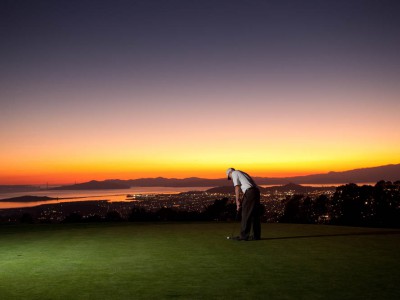
Berkeley Country Club’s putting green at dusk, with the San Francisco Bay lit by the setting sun.
In 1920 a constitutional amendment gave American women the right to vote, Prohibition commenced, and Robert Hunter looked out at his dramatic new golf course draped over the high eastern hills above San Francisco Bay, and knew that at least two of the three developments were good.
To borrow a line from Tom Wolfe, the location had views that would make the Sun King blink, commanding the heights over the distant city of San Francisco and its eponymous bay, to Marin County’s Mt. Tamalpais just north; smack in between sat the Golden Gate, which wouldn’t be spanned for another 16 years. And at the just-opened Berkeley Country Club, the golf course itself was a fine piece of work indeed.
Founding member and Greens Committee Chair Hunter – – who had a day job as a professor of sociology at the nearby University of California – – designed putting surfaces that were large, wickedly contoured and well trapped. Long holes were stout, yet offered strategic choices for drives and approaches. The par 3s, wrote Hunter, “are well distributed and of varying lengths,” where the “Wood, cleek, midiron and jigger must be used, and the shots must be well-nigh perfect to get the par.”
Today, as the Berkeley Country Club celebrates its Centennial, jiggers are found only in the bar of the Walter Ratcliff-designed Clubhouse, a sprawling English Tudor-style building that’s been updated and expanded, but retains the essence of the prominent Bay Area architect’s design. The par 3s still test a range of clubs. And while the course itself has gone through numerous evolutionary changes over a century, Hunter would instantly recognize almost every detail of his creation, thanks to a loving restoration.
The thing is, Robert Hunter is largely recognized only by golf course design aficionados – – nerds and geeks, really, who study the philosophies, quirks and eccentricities of
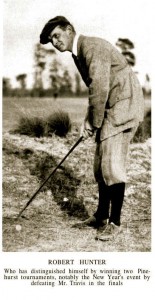
Young Robert Hunter, around the time he helped found Berkeley CC.
MacKenzie, Ross and Tillinghast, as if they were Yoda and Obi Wan Kenobi. Hunter was an unlikely giant of the Golden Age of Golf Course Architecture, which roughly spanned from the end of World War I until about 1930. While an excellent amateur golfer, the professor then had more chops as a socialist organizer than in landscaping, agronomy and course design.
Consequently, when Berkeley opened, it was Los Angeles-based Architect William “Willie” Watson, a native of Scotland, who received most of the media credit for the design and even its location. The prolific Watson eventually designed both courses at the esteemed Olympic Club in San Francisco, and several noteworthy private clubs in Southern California, including Brentwood, Hillcrest and Hacienda. Along with his long-time associate, James Watson, who supervised Berkeley’s construction, the pair brought instant and powerful credibility to an upstart club looking for members.
Hunter’s Solo Design
In truth, the self-educated Hunter likely controlled every detail of the land purchase and course design, suggests Golf Course Architect Forrest Richardson, who with his partner Mark Fine managed the Berkeley restoration in 2011 and 2012. “Being a socialist professor at Berkeley, Hunter was very likely cloaking his role in the founding and design of the course,” explains Richardson. “We like to say he hired Watson as a ‘ghost writer’ of a first draft, to prepare plans and essentially be the “front man’ in the early days. But once the work was underway, Hunter shifted to a major role and considered himself the designer.”
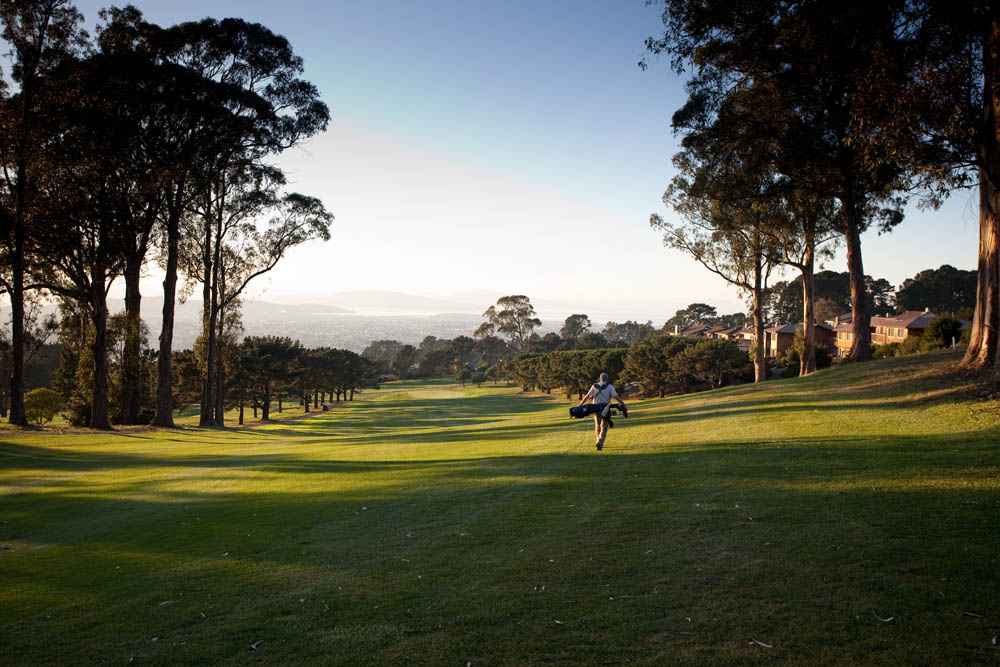
The downhill sixth hole on brings the round to the western half of the course.
In fact, after Berkeley, Hunter became a working partner with Alistair MacKenzie on the development of Cypress Point and other classics, a close association that’s mostly forgotten. In 1926, Hunter authored The Links, one of first comprehensive and most influential books on golf course architecture, a bible on how and why holes are structured, and the strategic choices imposed by a variety of hazards.
Above all, insists Richardson “Berkeley is Hunter’s only solo design,” a significance that makes his resurrected story a most apt fulcrum for the club’s Centennial celebration, and what the course means within the world of golf.
The Radical Professor
Berkeley is observing its Centennial with the introduction of a celebratory brand, on hats, shirts and other gear. “We’re planning on a kick-off cocktail party in late March,” says club General Manager Ryan Wilson. “In late May we’ll have a full celebration dinner and in September a Centennial golf event.” The club has also commissioned “Travelin Joe” Passov (formerly with Golf Digest) to write a commemorative book about the course, tournaments it has hosted, and a hole by hole description of the layout.
The book will certainly be an homage to Hunter, what with a proposed title of The Radical Professor of Golf Architecture: Robert Hunter and the History of the Berkeley Country Club. And it’s a fascinating history indeed.
Born in Indiana in 1874 to a prominent family that manufactured horse-drawn carriages – – creating wealth just in time – – Robert Hunter graduated from the University of Indiana and launched an early career as an organizer. He joined communes and became active in anti-tuberculosis efforts, and on formal commissions to end child labor. Essentially a democratic socialist probably to the left of Bernie Sanders, Hunter’s politics were likely informed by observing grinding poverty during recessions in the late 1800s, juxtaposed against his privileged upbringing.
Oddly enough, the ideology didn’t prevent him from developing a passion for golf and its field of play, especially “the maddening difficulty of it.” Hunter spent six months touring courses in Great Britain, and played most of the best in the Eastern United States, no doubt in the company of moneyed individuals.
After moving to California in 1918, Hunter lectured on politics and economics at UC Berkeley. He continued to refine and improve his game and allegedly had a handicap as low as a four. In 1922 he even won a prestigious tournament at the three-year-old Pebble Beach Golf Links. A student of the best players from Britain and the “high-class courses in eastern states,” Hunter was determined to develop and promote equally fine and challenging golf courses in California, which to his thinking would produce “first class golfers who will be the equal of those abroad.”
One of about a dozen founding members of the Berkeley Country Club, Hunter searched the hills above Berkeley and Oakland for a proper course and club site. It was
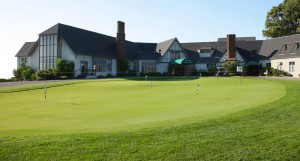
The Walter Ratcliff designed Clubhouse is still a classic Tudor structure.
just above El Cerrito where he found a relatively flat plateau with loamy soil, with the spectacular San Francisco Bay to the west, and Wildcat Canyon to the east. The group purchased 175 acres of land, near which housing had been planned, which included about 50 acres that could be sold in the future to eliminate debt.
A charter membership could be had for $300. A newspaper clipping from the time said the club also hoped to limit membership to 300, “including men and women, and the latter will have equal privileges and property in securing charter certificates.” Given the 19th Amendment, which was ratified in August of 1920, equality was obviously important to Hunter.
“When you look at photographs from the 1920s and 1930s, you see a remarkable number of women playing golf,” explains Richard Pettler, an immigration attorney and former Berkeley CC Board member, President and de facto club historian. “At Berkeley, they were very prominent women.”
The Mira Vista Era
Hunter had hoped to develop a golf club similar to that at Stanford University, says Pettler, with a relationship that bound the golf course and university tightly together. For a time, Golden Bear golfers practiced and played on the hilltop course. But a formal and lasting relationship with the university, Pettler adds, “never happened.”
In 1929, the club hosted the Berkeley Open, something of an early club apotheosis in which Walter Hagen competed, and which was won by Horton Smith, later famous for winning the inaugural Masters. Even as the Great Recession shredded the global economy, the club hung on for years. The East Bay Printers association held its annual May Golf Tournament and Dinner there, at least through 1933.
Alas, economics eventually took a toll and membership dropped. In 1944, during the final but excruciatingly uncertain year before the end World War II, the club reorganized and adopted a new name, the Mira Vista Golf and Country Club. The nomenclature was memorable, appropriate for the site, and lasted until 2017, when equity members voted to return the club’s name to the original Berkeley.
Mira Vista nonetheless still endures in the navigation systems of cars four years old and older.
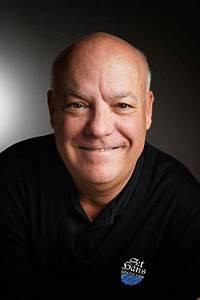
Golf Course Architect Forrest Richardson, who in 2012,with partner Mark Fine, brought back Robert Hunter’s original intent.
Many of Hunter’s original touches and flourishes, however, slowly vanished over nearly 90 years. Strategic fairway bunkers were sacrificed for easier maintenance. The lines of greenside bunkers lost their original definition. Stands of trees, and in particular eucalyptus, grew tall and blocked at least four stunning viewpoints. And except for those geeks and nerds, Robert Hunter was generally forgotten, until the right person was hired to renovate the course.
Enter Forrest Richardson
A Loving Restoration
Outgoing, engaging and intellectually playful, the Arizona based Richardson makes it a point to research and learn as much as is possible about a golf courses’ architect of record, his partners and the conditions under which the course was built, even before bidding on renovation projects. Highly regarded for his original designs, Richardson’s respect for original intent is one of his most commendable qualities, along with a commitment to keep golf fun.
With major contributions from partner Mark Fine, Richardson consulted original Berkeley Country Club maps, yet found the only three remaining photographs of the 1920 course. Equally important, then, was their intimate understanding of The Links, a blueprint of Robert Hunter’s thinking, and other classic design principles.
In his own book, Bunkers, Pits & Other Hazards, written with Fine, Richardson makes frequent reference to Hunter and his work. He emphasizes that hazards are “the heart and soul of the game . . . (and) . . . the most defining components of a golf course.” At Mira Vista, many of those had gone missing, as were many of the views.
“Several of the great hallmarks of the course had become shrouded by enormous eucalyptus and other large trees over about 75 years,” says Richardson, who had been studying Mira Vista for about five years before starting his renovation. After heavy duty logging, grand views at more than two dozen points across the layout were revealed.
Green shapes and sizes were restored to their more original condition, although there’s clearly the Forrest Richardson touch in some of the more dramatic contours. Fairway cross bunkers, such as those on hole number 10, which vanished around World War II, have been reintroduced in order to bring back the original lines of play.
“We put in 15 bunkers that had been lost,” says Pettler, “or which had been in the plans but never built.” The former BCC president was particularly pleased with the restoration of the risk and reward seventh hole. Once an uphill par three, it’s now a short but still uphill par four, drivable only by the big boys and girls, and fronted by an array menacing bunkers. Richardson also discovered that a drainage ditch across the par five 8th hole had been covered. Now unearthed, it’s a hazard from the tee box, forcing a well struck drive to carry and a chance to reach in two, or a safe layup that makes it a stiff three-shot hole.
“Our primary goal was a more thought-provoking golf experience,” says Richardson, “one grounded with options and decisions at every tee and approach.”
A Breathtaking Contrast
In general, the Berkeley County Club is itself a thought-provoking place, golf aside. About half of its holes are on the west side of the property, with expansive

Berkeley’s new logo, developed for the Centennial.
views of
where most of the Bay Area’s 7 million people reside. The first five holes of the course string down and back along the east side, another world, in a narrow, indented piece of Wildcat Canyon. There are a few apartment and condominium buildings where the routing returns along the 16th and 17th holes, but to the east of that is open space, golden and hilly terrain habituated by only a handful of Angus cattle.
The contrast with the urbanity is breathtaking.
Robert Hunter believed that if fairways funneled shots to oversized holes, the game of golf would quickly grow boring. Consequently, at Berkeley, he claimed that “The way to the hole is often tormented and narrow . . .”
It’s hard to feel tormented by a round at the Berkeley Country Club. There are challenges, but the golf here is never tedious. And no matter what happens with one’s score, there are mesmerizing vistas that make could anyone and everyone, including a Sun King, blink.
